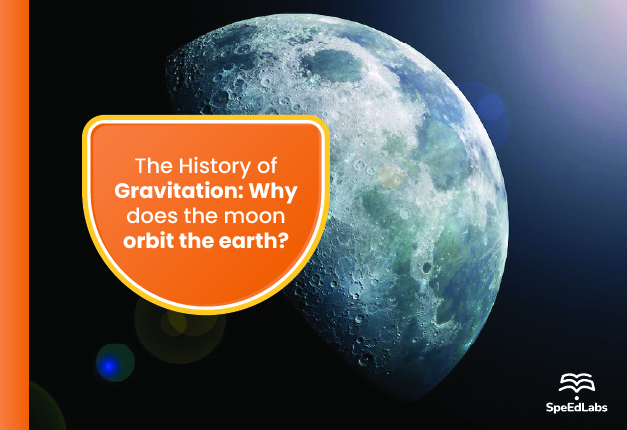The Moon is the only natural satellite Earth has and Earth maintains the revolution of the moon around it. We all know this! However, why does this happen? Is there any interesting history behind this?
What keeps the Moon revolving around the Earth?
Due to the influence of gravity, the moon revolves around Earth. As two objects are separated from one another, the gravitational pull becomes weaker. Given the size of the Sun and its great distance from the moon, its gravitational pull on the latter is weaker than that of Earth.
What is Gravitational pull dependent on?
- Gravitational pull is subject to the inverse-square law, which states that as the square of the distance between two bodies increases, so does the pull’s strength.
- For a ten-fold increase in distance, the strength declines by a factor of 100.
- However, the Sun, which makes up 99.8% of the mass of the entire Solar System, is so massive that even though it is nearly 150 million kilometres from Earth, it still pulls the moon, which is only 384,000 kilometres away, with a gravitational force that is rough twice as strong as that which Earth exerts on our nearest planetary neighbours.
Where did Moon come from?
One of the objectives of the Apollo programme was to determine how we came to have our Moon. There were previously several theories regarding how the Moon was created.
There were three theories about how the Moon formed before the Apollo missions, according to research.
- According to the capture theory, the Moon was once a roving body (similar to an asteroid) that formed elsewhere in the solar system and was drawn in by the gravity of Earth as it passed by.
- On the other hand, the accretion theory postulated that the Moon formed at the same time as the Earth. The fission scenario concluded that Earth had been spinning so quickly that some material had finally broken away and started to orbit the planet.
- The giant-impact theory is currently the one that is most widely accepted. According to this theory, the Moon was created when the Earth collided with a smaller planet that was roughly Mars’ size. The Moon was created when the impact’s leftover debris gathered in an orbit around Earth.
Well then, we see that the moon is attracted toward the earth due to gravity. However, what is the history of gravity?
The history of Gravity
The concept of gravity was only recently understood by humans (like within the last 300 years).
- Greek philosophers believed that the planets and stars had a “natural motion” and belonged to the world of the gods. They had no idea that gravity was at play. Up until the 16th century, Greek ideas were still prevalent.
- In the early 1500s, astronomers like Galileo and Brahe realised the earth and other planets were revolving around the sun. They did not move in a circle, as Kepler demonstrated, but rather in an elliptical orbit. Why was the central query?
The Father of Gravity: Sir Isaac Newton
Sir Isaac Newton, an English mathematician, physicist, and mathematician, lived from 1642 to 1727.
- The story goes that Newton was contemplating the forces of nature when he witnessed an apple falling, which led him to discover gravity.
- Whatever occurred, Newton understood that a force must be at work to cause falling objects like apples to begin moving after being at rest.
- Newton also understood that if a force were not causing the moon to fall toward Earth, it would fly off from the planet in a straight-line tangent to its orbit. The moon is merely a projectile orbiting the Earth attracted by gravity.
- Newton designated this force as “gravity,” and he concluded that all objects are subject to gravitational forces.
- Newton was able to explain Kepler’s astronomical observations by using the concept of gravity.
- The work of Galileo, Brahe, Kepler, and Newton established beyond any doubt that the Earth was not the solar system’s centre. The Earth orbits the sun in the same general direction as the other planets.
- Later, J.C. Adams and U.J.J. LeVerrier, two astronomers, used the idea of gravity to foresee the discovery of the planet Neptune. Uranus’ orbital anomalies led them to the conclusion that there must be another planet acting as a gravitational pull on it. (Orbital deviations are perturbations).
The General Theory of Relativity by Albert Einstein
- Einstein created a completely new theory of gravity.
- Einstein postulated that the “warping” of space and time is the source of gravity.
- Numerous phenomena that would conflict with Newton’s theory are explained by Einstein’s new theory of gravity. For instance, when passing by large objects like the Sun, light bends.
Additionally, a clock elevated above the Earth runs faster than a clock on the surface.
Also published on Medium.
